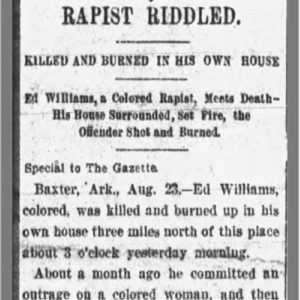calsfoundation@cals.org
Edward Williams (Reported Lynching of)
In January 1898, the Chicago Tribune reported on the August 26, 1897, lynching of an African American man named Edward Williams near Baxter (Drew County). He was being sought for allegedly assaulting a Black woman. This information appeared in Ralph Ginzburg’s book 100 Years of Lynchings and has more recently appeared on several online lynching lists. The date of this reported lynching is apparently incorrect, as the first news of it appeared in the Pine Bluff Daily Graphic on August 24, 1897. According to the Daily Graphic, “Ed Williams, a negro rapist, was strung up by a mob near Baxter, Ark., Monday morning.” Monday would have been August 23. Also on August 24, the Topeka State Journal published another report, stating that Williams had been killed when fire was set to his house while he was in it.
A more extensive report, first published in the Arkansas Gazette on August 24, was datelined Little Rock (Pulaski County), August 23. According to the Gazette, Williams was “burned up” in his house three miles north of Baxter at 3:00.a.m. “yesterday morning,” which would have placed the date on August 22. According to the Gazette, sometime in July, Williams had “outraged” an African American woman, and had informed the local deputy sheriff that he would kill the sheriff if he attempted to arrest him. There was a delay in the arrest, but on “Saturday evening” (August 21) Deputy Sheriff Will Hammock and a posse set out from Monticello (Drew County) to arrest Williams, and by 1:00 a.m. on Sunday, they had his house surrounded. According to the Gazette, Hammock’s posse included at least two Black men, and possibly more. When they approached the door of Williams’s house, his wife refused to open it but called out that Williams was not at home. When they failed to persuade her to turn him over and could not force the door, they set the house on fire, and “not until the roof was falling in did the door open, when the woman ran out, brushing coals of fire from her head.” Once she left the doorway, Williams was visible with a rifle in his hand. A member of the posse fired, killing him. The roof fell in before posse members could remove Williams’s body from the building. According to the Gazette, “This county is rid of one of its worst citizens…and his neighbors will be able to get possession of their stolen property, which Williams has been accumulating for years.” They asserted that “the brutal desperado” had terrified them so much that they had not demanded their property. Prior to his alleged crimes in Drew County, Williams had reportedly been in the penitentiary twice, once in Mississippi for horse stealing and later near Helena (Phillips County) for rape. Both this article and briefer ones were reprinted in newspapers across the country.
In January 1898, the Chicago Tribune published its annual list of lynchings and included the information that Williams had been lynched near Baxter on August 26, 1897. The facts were disputed by the Arkansas Democrat. Quoting editor James R. Cotham of Monticello, it reported that “Williams was killed on the 21st of August, 1897, by deputy sheriff and posse, while openly resisting arrest.” The Democrat went on to say, “It is no evidence that a lynching has occurred to show that a body has been found and that a death resulted from foul means. The same thing happens every week in Chicago, and no one ever reports that a lynching has occurred.”
For additional information:
“The Chicago Tribune’s Statement.” Arkansas Democrat, January 27, 1898, p. 2.
“News in Brief.” Pine Bluff Daily Graphic, August 24, 1897, p. 1.
“Rapist Riddled.” Arkansas Gazette, August 24, 1897, p. 1.
“Shot and Cremated.” Topeka State Journal, August 24, 1897, p. 8.
Nancy Snell Griffith
Davidson, North Carolina
 Civil Rights and Social Change
Civil Rights and Social Change Post-Reconstruction through the Gilded Age, 1875 through 1900
Post-Reconstruction through the Gilded Age, 1875 through 1900 Edward Williams Lynching Article
Edward Williams Lynching Article 




Comments
No comments on this entry yet.